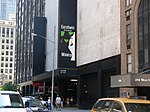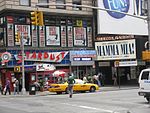The Neil Simon Theatre, originally the Alvin Theatre, is a Broadway theater at 250 West 52nd Street in the Theater District of Midtown Manhattan in New York City. Opened in 1927, the theater was designed by Herbert J. Krapp and was built for Alex A. Aarons and Vinton Freedley. The original name was an amalgamation of Aarons's and Freedley's first names; the theater was renamed for playwright Neil Simon in 1983. The Simon has 1,362 seats across two levels and is operated by the Nederlander Organization. Both the facade and the auditorium interior are New York City landmarks.
The facade is divided into two sections: the six-story stage house to the west and the five-story auditorium to the east. The ground floor is clad with terracotta blocks and contains an entrance with a marquee. The upper stories of both sections are made of brick and terracotta; the auditorium facade has arched windows, niches, and a central pediment, while the stage house is plainer in design. The interior is designed in the Adam style and includes two lobbies and a mezzanine-level lounge. The auditorium consists of a ground-level orchestra and one balcony with boxes. The theater interiors are decorated with paneling and plasterwork, and the auditorium has a domed ceiling. Above the auditorium were three stories of offices.
Alexander Pincus and M. L. Goldstone developed the Alvin Theatre, which opened on November 22, 1927, with Funny Face. Aarons and Freedley initially operated the theater and owned it from 1930 to 1932. In the theater's early years, it hosted musicals such as Anything Goes, Lady in the Dark, and Something for the Boys, as well as plays. CBS took over in 1946 and continued to operate the theater until 1959, when Max and Stanley Stahl bought it. The Alvin was further sold in 1967 to Rock-Time Inc. and in 1975 to the Nederlanders. Through the 1960s and 1970s, the Alvin hosted long runs of shows such as A Funny Thing Happened on the Way to the Forum, High Spirits, The Great White Hope, Company, Shenandoah, and Annie. After the theater was renamed for Neil Simon, it hosted several of his plays during the 1980s and 1990s, as well as the musical Hairspray during much of the 2000s.










